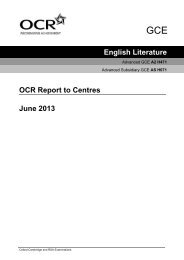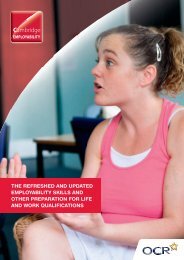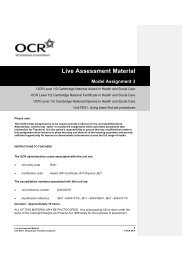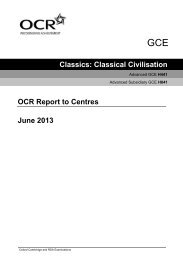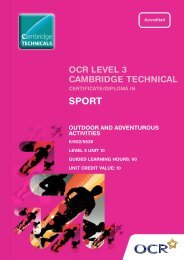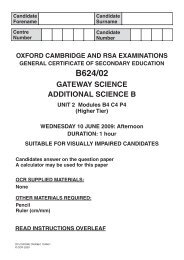Level 2 - Unit 24 - Animation techniques (PDF, 2MB) - OCR
Level 2 - Unit 24 - Animation techniques (PDF, 2MB) - OCR
Level 2 - Unit 24 - Animation techniques (PDF, 2MB) - OCR
You also want an ePaper? Increase the reach of your titles
YUMPU automatically turns print PDFs into web optimized ePapers that Google loves.
a visit to an animation company will give learners further<br />
experience of how animation can be improved with additional<br />
software <strong>techniques</strong>. The visit may also look at, or learners<br />
can be taught, that animation is split into three phases; preproduction,<br />
production and post-production and what is<br />
involved in each of these phases. Learners must be taught<br />
about differing formats that animations can be exported in<br />
and which best suits different delivery methods and audience<br />
e.g. movie format, shockwave format.<br />
Be able to review own animation production<br />
Learners should look at animations that currently exist and<br />
their own animations and in groups review the animations<br />
(both existing animations and their own) looking at its<br />
strengths and weaknesses (e.g. suitability for audience,<br />
storyline, colours used), as well as deciding if the animation<br />
has met its objectives and how they could be improved.<br />
Learners can feedback to other members of their group or<br />
discuss what they have found through their group work to the<br />
whole class. Learners should be taught how to create a test<br />
plan and could then use this to test an existing animation –<br />
the centre should find a good test plan and a bad one in order<br />
to contrast the differences (this could be one constructed by<br />
the tutor). Possible errors could include the frame rate being<br />
too fast making it difficult to read captions and text, or the<br />
animation may not be fit for its audience etc. Learners should<br />
be taught appropriate methods for collecting feedback on<br />
animations and understand evaluation <strong>techniques</strong>. Within<br />
their groups they can be given a set of questions to see<br />
how they would respond to these questions. These can be<br />
a mixture of open and closed questions so that learners<br />
understand how to gain useful responses depending on the<br />
questions asked and how these questions are phrased.<br />
www.ocr.org.uk<br />
6



